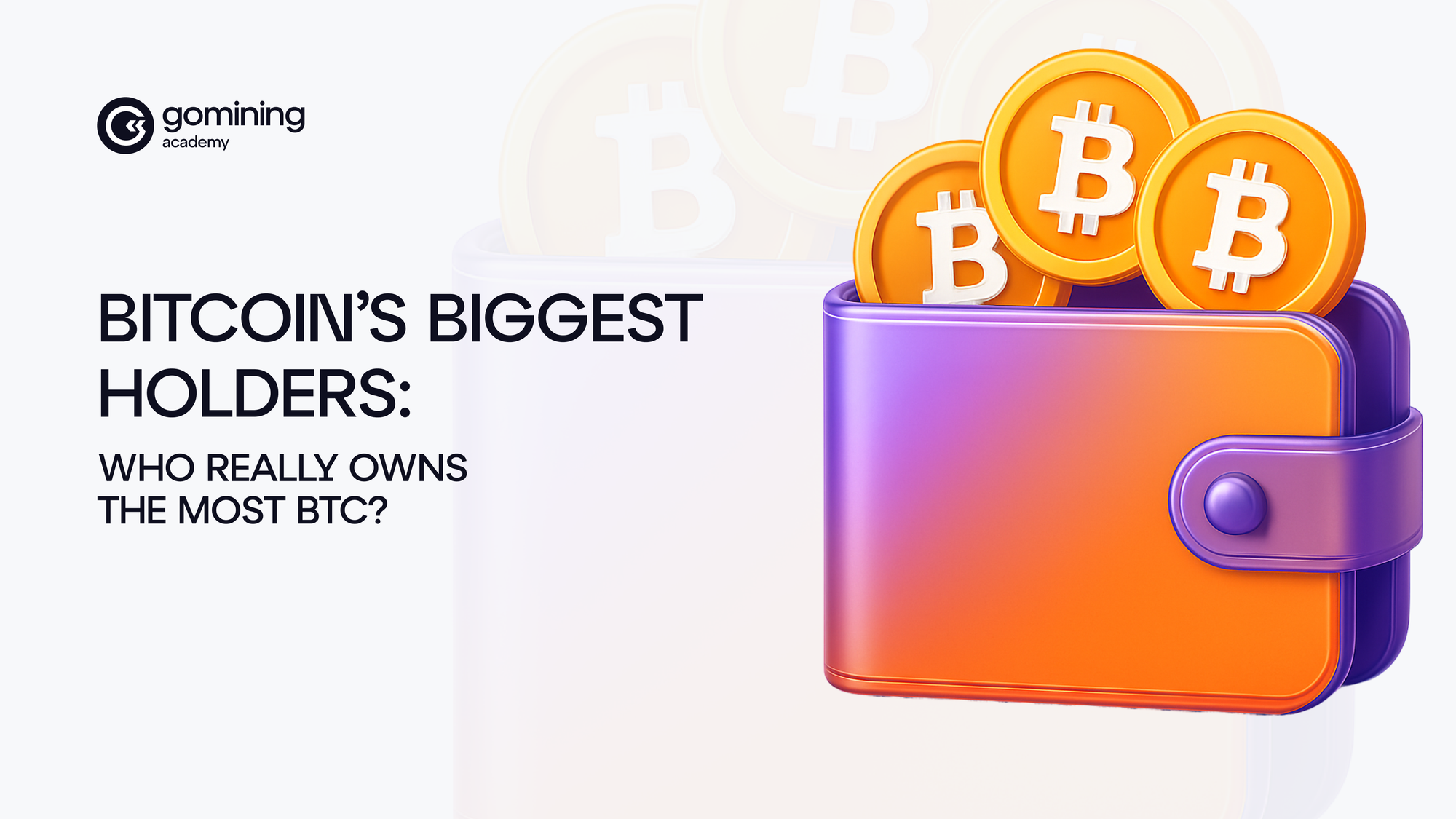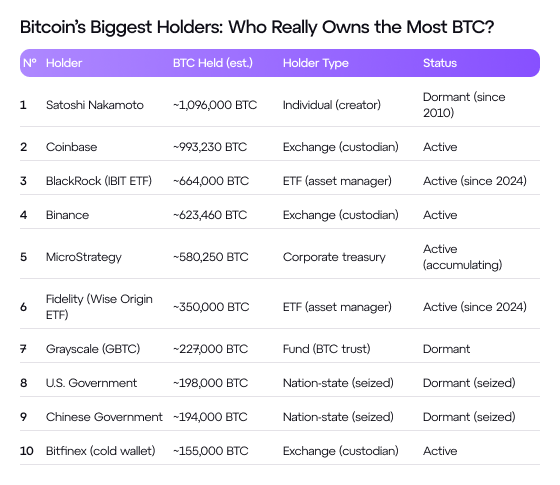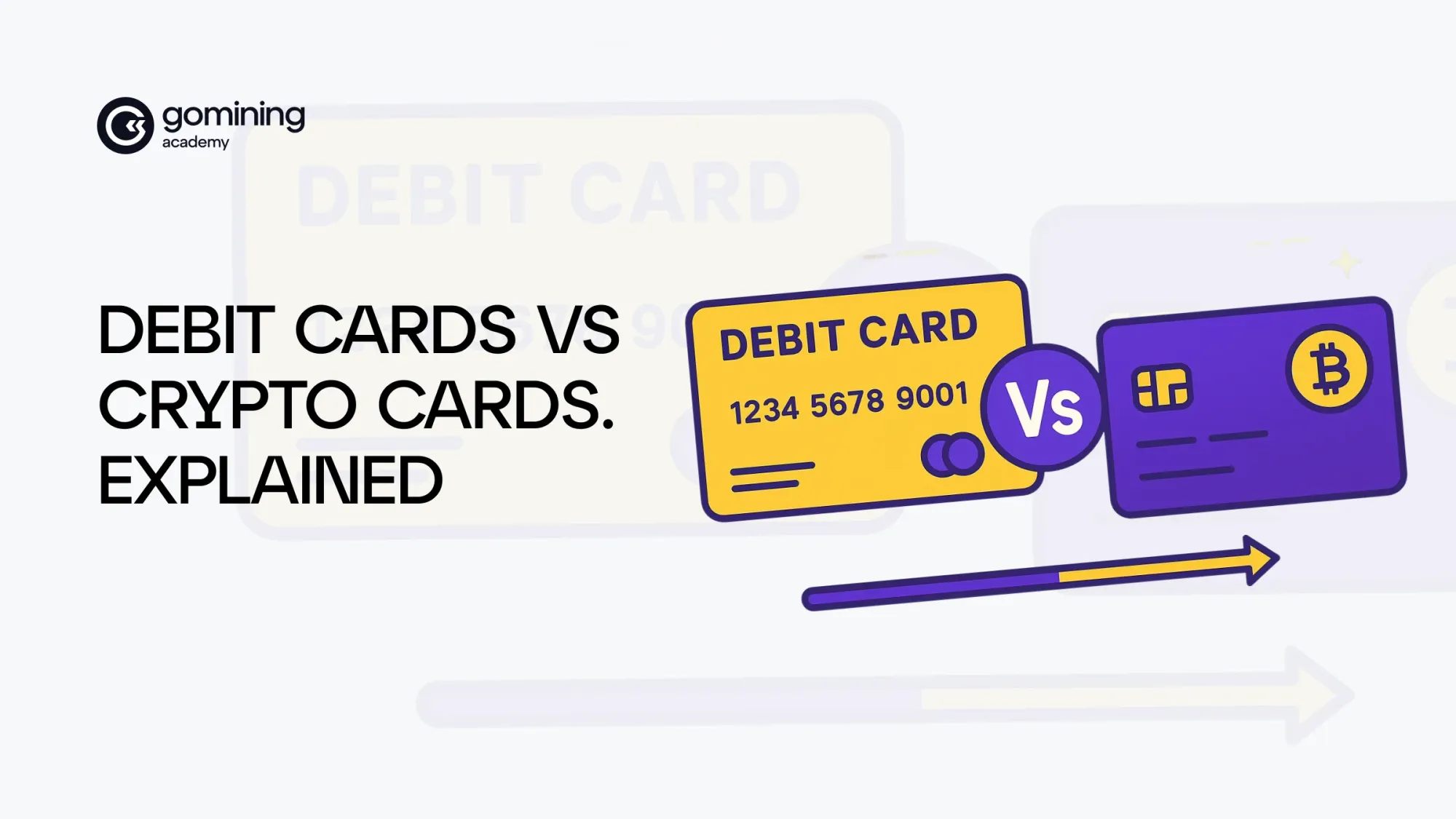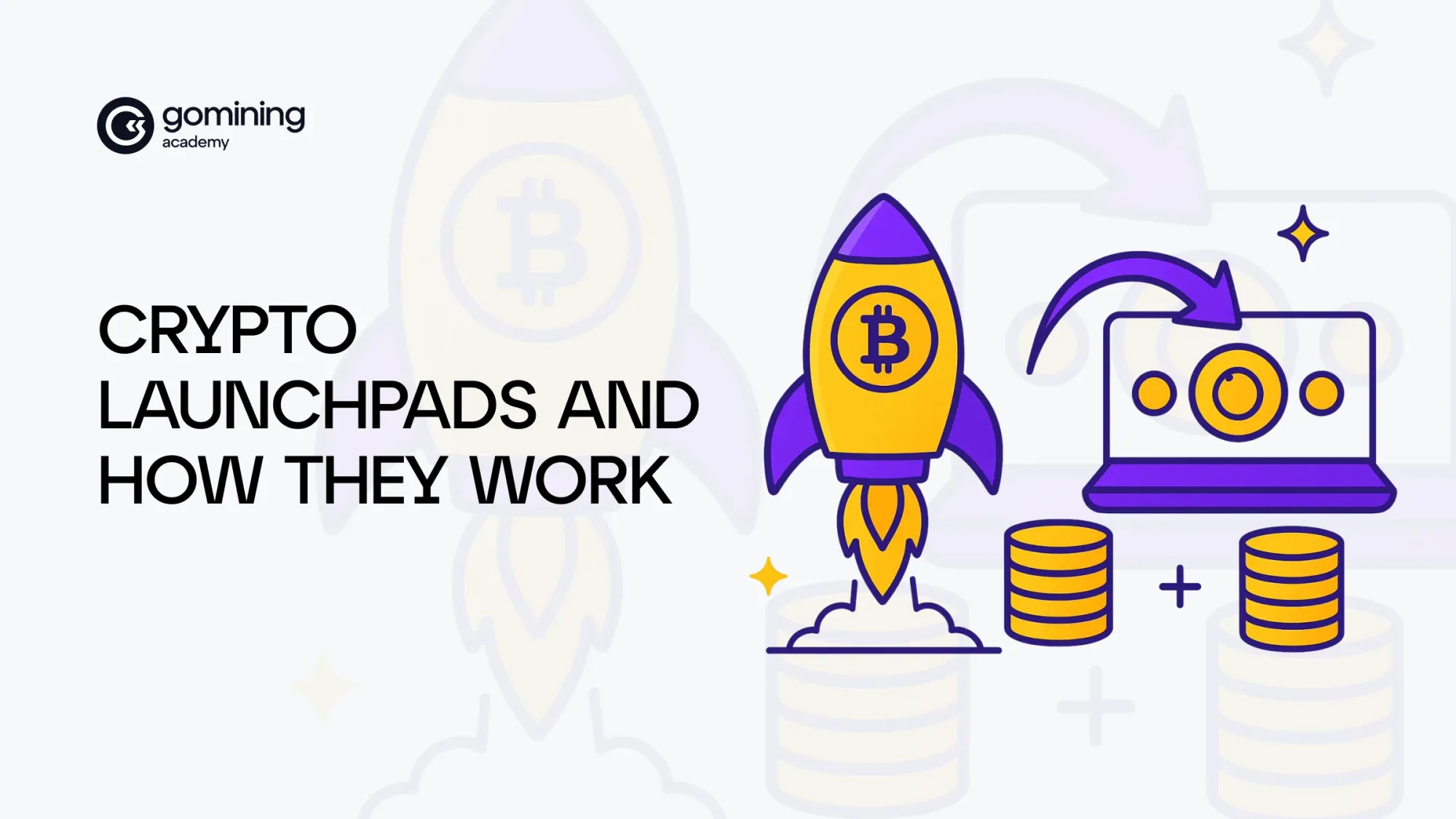Bitcoin’s Biggest Holders: Who Really Owns the Most BTC?

Who Really Owns Bitcoin?
When you hear “biggest Bitcoin holder,” what comes to mind?
Maybe you picture a billionaire, a tech CEO, a government, or the mysterious creator behind it all. But with Bitcoin, ownership works differently.
If Bitcoin were a city, wallets would be buildings. Some are towering megastructures holding billions. But most are just everyday apartments with a few digital coins inside.
It is a skyline that doesn’t show names, only addresses. And behind those addresses? People, companies, and even countries — quietly holding thousands of coins. Some wallets haven’t moved in years, while others shift billions in a single tap.
In Bitcoin’s world, you can’t always see who owns what, only how much, and whether it’s moving. And that’s where the real story begins.
In this article, we’ll explore the biggest Bitcoin holders in 2025 — not just who (or what) they are, but why that matters more than ever.
Because sometimes, how something is owned tells you more than who owns it.
Table of Contents:
- The Richest Silent Bitcoiner Who Never Spent a Coin
- Who’s Really Holding All the Bitcoin? A Look Inside the Top Wallets
- The Ones Who Move Quietly: Whales and Governments
- The Gatekeepers: Who Holds Bitcoin for Millions of Others?
- Why It Matters Who Holds Bitcoin — and What That Tells Us in 2025
The Richest Silent Bitcoiner Who Never Spent a Coin
The crypto world is full of stories and legends. But which one do you think is the oldest, strongest, and most famous of all?
He mined the first block. Vanished without a trace. And left behind a treasure chest no one dares to open. The one name nobody truly knows: Satoshi Nakamoto.
We don’t know who Satoshi Nakamoto really was — a lone genius, a small team, or a ghost of the early Internet. But one thing’s certain: whoever they were, they hold more Bitcoin than anyone else on Earth.
Onchain data shows that wallets linked to Satoshi’s early mining still hold around 1.1 million BTC. That’s over 5% of the total supply — untouched, unspent, and silent since 2010.
If Satoshi returned today, they’d instantly be the richest person in crypto. But the coins remain still. Why the silence?
Well — almost still.
In May 2024, a decade-old wallet suddenly moved 687 BTC, worth over $43 million. And it wasn’t the first. In 2023, a handful of early wallets from 2010 and 2011 stirred, transferring millions in Bitcoin. Experts say they likely belong to early adopters — not Satoshi — but every time it happens, curiosity spikes.
Are these wallets lost forever? Or is someone still watching, waiting? A single movement from Satoshi’s stash would ripple through the entire ecosystem — not because of what it proves, but because of what it might mean.
But maybe that silence is the point. By walking away — and never cashing out — Satoshi helped cement Bitcoin’s core idea: a network with no leader, no single point of control, and no founder profiting behind the scenes.
In a space full of noise, one figure said nothing. And that silence still speaks louder than words.
Who’s Really Holding All the Bitcoin? A Look Inside the Top Wallets
Let’s zoom out for a moment…
As of 2025, over 19.7 million bitcoins are already in circulation, and a huge portion of them aren’t moving. Some wallets have been silent for years. Others belong to exchanges, investment funds, or governments.
But… who’s actually holding all this Bitcoin?
Here’s a current snapshot of the largest known holders, based on public blockchain records and analysis from Arkham, Glassnode, and BitInfoCharts. It shows more than the names of what kind of players dominate the BTC ownership landscape.

As you can see, together, these ten entities control nearly 5 million BTC, almost 25% of all the Bitcoin that will ever exist.
Some of those coins are held for everyday users on platforms like Coinbase and Binance. Others sit in vaults built for ETFs and institutions. A few, like Satoshi’s stash, haven’t moved in over a decade. And some belong to governments that seized BTC through criminal cases, and haven’t touched it since.
Quick facts:
- Satoshi’s ~1.1M BTC is spread across ~20,000 addresses. None have ever moved.
- The top exchanges hold around 12% of the supply, pooled from millions of users.
- Large institutional holders like BlackRock and Fidelity accumulated hundreds of thousands of coins after the 2024 approvals.
- Governments like the U.S. and China hold close to 200,000 BTC each, seized but dormant.
Now pause and think: Just 10 entities, ranging from a pseudonymous creator to trillion-dollar firms and global governments, hold a quarter of all BTC.
So, do you think “Who owns Bitcoin?” is the only question worth asking?
What about:
- How concentrated is it?
- Who’s holding tight — and who’s holding for others?
- Who could move the market… and who chooses not to?
Let’s try to find the answers in the next sections. Because who holds Bitcoin shapes how it moves — or doesn’t. It affects liquidity, price swings, and the network’s sense of balance. If 70% of BTC is sitting still, it’s the movers who set the pace.
And in this city of digital wallets, the biggest buildings aren’t always the loudest.
Sometimes, the quietest ones are holding the most keys.
The Ones Who Move Quietly: Whales and Governments
You’ve seen the skyline. Now let’s step inside. Some of Bitcoin’s biggest holders don’t make noise. They don’t post, don’t sell, or even blink.
In crypto, they’re called whales — wallets with over 1,000 BTC. Enough to tilt sentiment, set off alerts, or spark a hundred headlines without saying a word. Some of these whales are people. Others are funds or entire nations.
Their wallets sit still and quiet sometimes for years. But what happens when they do move?
The Philanthropic Phantom: Pine and the $86M Bitcoin Giveaway
How many times have you heard stories about whales moving huge BTC amounts and crashing the market? Well, this one moved differently, reshaping the story.
In December 2017, an anonymous Reddit user named “Pine” posted something no one expected: They were donating 5,057 BTC — worth $86 million at the time — to charities around the globe.
“The expectation shattering returns of Bitcoin over many years has [led] to an amount far more than I can spend. What do you do when you have more money than you can ever possibly spend? Donating most of it to charity is what I’m doing,” Pine wrote.
Over five months, they donated to more than 60 organizations — from psychedelic research and water access to privacy rights and cancer cures. A few highlights:
- $5M each to GiveDirectly, Open Medicine Foundation, and MAPS
- $3 million total to SENS Research Foundation and Methuselah Foundation
- $2 million to the Organ Preservation Alliance
- $1 million each to Watsi, The Water Project, BitGive
Pine never revealed their identity. They never sold the story to a Netflix doc. They just vanished, leaving behind the Pineapple Fund and a ripple of generosity few in crypto have ever matched.
And in a space filled with speculation, they left behind something rarer: a reminder.
Most whales stay silent for a reason. They accumulate in downturns and vanish in upswings. But sometimes… they reappear — not to cash out, but to leave a mark.
If your wallet suddenly held millions, what would you do?
Corporate Whales: The Strategic Accumulators
Not all whales hide. Some file quarterly reports and shareholder letters.
Take MicroStrategy. Once a traditional software firm, it pivoted hard into Bitcoin in 2020. By 2025, it holds over 580,000 BTC — stored across multiple wallets and disclosed through SEC filings rather than splashy press releases.
Their strategy is simple: buy with cash flow, buy with bonds, and hold. No flip trades. Just quiet, deliberate accumulation.
And then, came the ETFs.
After U.S. regulators approved spot Bitcoin ETFs in 2024, financial giants like BlackRock (IBIT) and Fidelity (Wise Origin) stepped in. Think of an ETF — or Exchange Traded Fund — as a wrapper that lets everyday investors gain exposure to Bitcoin, without having to buy or store the asset themselves.
Behind the scenes, these ETFs began stacking BTC on behalf of their clients. But they don’t keep the keys. Instead, Bitcoin is held in cold storage — ultra-secure, offline vaults — managed by professional custodians like Coinbase Custody and BitGo.
These wallets are built for safety, not speed. They rarely move. And that slow, steady accumulation has shifted the rhythm of the market.
Bitcoin isn’t just a retail rollercoaster anymore. It’s also a shelf of quiet reserves — guarded by institutions, stacked for the long term.
Still, that shift brings a question with it:
Can Bitcoin stay decentralized… if so much of it ends up in just a few corporate hands?
Governments in the Table
Bitcoin was designed to operate beyond borders — yet today, some of its largest holders are nation-states. Let’s start with two that rarely sit on the same side of the table: the United States and China.
What do they share in the world of Bitcoin?
Surprisingly, both hold massive amounts of BTC — not because they invested early, but because they seized it. Coins confiscated from dark web busts, cybercrime cases, and bankrupt exchanges now sit in government-controlled wallets.
That’s where the paths split.
In the U.S., those holdings — nearly 198,000 BTC — are managed with increasing transparency, often auctioned or stored by federal agencies. Some even call it a “Digital Fort Knox.”
China’s stash, estimated at around 194,000 BTC, is more opaque. It’s scattered across agencies, and there’s little public clarity on whether it’s being sold, held, or used strategically.
But not all government wallets come from seizures. Some countries choose Bitcoin actively, strategically, and sometimes quietly.
In 2021, El Salvador made headlines as the first country to adopt Bitcoin as legal tender. But it wasn’t just a political stunt. They bought BTC with public funds and built a national wallet that now holds over 6,200 BTC.
For them, Bitcoin isn’t just an asset; it’s part of a larger push toward independence: reducing remittance fees, diversifying reserves, and inviting new kinds of investment.
And then there’s Bhutan — a country that never made a big announcement, never staged a Bitcoin summit… but mined quietly in the background. Using hydropower from its mountainous terrain, they built a sovereign mining operation that by 2025 had quietly accumulated over $900 million worth of BTC.
One bought in, the other mined their own.
Some countries treat these coins as strategic reserves. Others just haven’t figured out what to do with them yet. Either way, the presence of states at the Bitcoin table adds a layer of complexity — and power — that most people didn’t see coming.
When Big Players Don’t Move
Most of these wallets haven’t moved in months or years. And when that much Bitcoin sits still, a few things start to happen:
- Liquidity shrinks — fewer coins available for trading
- Market reactions intensify — small movements cause bigger waves
- Ownership concentration grows — power rests with the stillest hands
Together, whales, ETFs, and governments now hold millions of BTC. And in many cases, they aren’t trading. They’re holding.
So here’s a question to carry forward:
If Bitcoin was meant to be decentralized — but a quarter of it lives in just a few quiet wallets — what happens next?
Because in this network, the loudest voices don’t always hold the most power. Sometimes, it’s the silent ones who shape the future.
The Gatekeepers: Who Holds Bitcoin for Millions of Others?
When people picture the biggest Bitcoin wallets, they often imagine whales — early adopters, billionaires, or deep-pocketed institutions.
But some of the largest wallets don’t belong to individuals at all.
They belong to custodians — companies like Coinbase, Binance, and Bitfinex — that manage Bitcoin on behalf of millions of users.
Instead of each person holding their own wallet, these platforms pool BTC into a few large addresses. That’s why, on chain, they look like giants. But behind those big balances are millions of smaller accounts, from casual buyers to active traders.
Exchanges Are the Castle — Not the Treasure
How do custodial wallets work?
Think of it like a medieval castle, where you store your gold for safekeeping. You can’t forget that the drawbridge, the guards, and the keys belong to someone else. You still own the value, but not the keys to the vault.
When you buy Bitcoin on an exchange like Coinbase or Binance, your coins don’t go into a personal wallet. They go into the exchange’s wallet, and your access is through their platform.
It’s convenient. Secure (usually). And for many people, it’s how they got started with Bitcoin in the first place.
But this is something most in the crypto space tend to forget: you’re trusting a third party to hold your coins.
Trust, Convenience… and the Bigger Picture
But if the drawbridge, the guards, and the keys belong to someone else, why do people keep their coins on exchanges?
Custodians make Bitcoin more accessible. They’ve helped millions of people enter the space, without needing to manage seed phrases or hardware wallets.
But they also reintroduce something Bitcoin was built to avoid: central points of failure.
When one custodian holds hundreds of thousands of coins, it concentrates risk. Hacks, policy changes, or outages can affect a huge number of users at once. And while most custodians have strong protections in place, the risk is part of the model.
So we’re left with a core tension — one that Bitcoiners have debated since the beginning:
Do you trust yourself to hold your own keys? Or do you trust someone else to do it for you?
There’s no single right answer. But it’s a question worth asking — especially if your BTC lives behind someone else’s drawbridge.
Why It Matters Who Holds Bitcoin — and What That Tells Us in 2025
We began with a question: Who really owns Bitcoin? And along the way, we found a more interesting one: How is Bitcoin being held — and why does that matter?
After exploring the data, the wallets, and the silent giants behind them, one thing is clear: Bitcoin’s supply may be fixed, but its influence flows differently depending on who holds it, and how they behave.
Stillness Creates Scarcity — and Sensitivity
Many of the biggest Bitcoin holders today — from governments and ETFs to early whales — aren’t moving their coins.
Some wallets have been untouched for over a decade. Others belong to custodians managing assets on behalf of millions. A growing number are strategic reserves — bought, mined, or seized — and stored deep in cold wallets by institutions or states.
Ever wonder what happens when billions in BTC sit untouched, month after month?
- Liquidity shrinks, making the active supply smaller than it looks
- Market reactions intensify because fewer coins move in the open
- Zones of influence emerge, where certain wallets are watched like weather stations, alerting traders and analysts with every small shift.
This is where power shows up, not through control, but through weight and attention.
So, Why Should You Know Who Holds What?
Bitcoin may be decentralized by design, but its ownership map tells a story of power, pressure points, and potential.
When you know who’s holding, you can:
- See how the supply is really distributed
- Anticipate where pressure might come from
- And better understand the mood, flow, and structure of the entire network
We’re not here to point fingers or crown heroes. We’re here to read the terrain.And now, you can too.
What Still Holds True
Even with all that weight at the top, Bitcoin remains open. You don’t need a vault of BTC to be part of it. You don’t need permission to join, hold, mine, or learn. Whether you have 0.0001 BTC or 100, you’re part of the same network and hold your own slice of the map.
That’s why knowing who the biggest holders are doesn’t diminish your place; it deepens your context. It helps you navigate.
Want to Go Deeper?
The GoMining Academy is built for this. If you want to understand how mining works, how hashpower fits in, or how to earn Bitcoin step-by-step, we’ve got you covered.
👉 Start learning at the GoMining Academy


